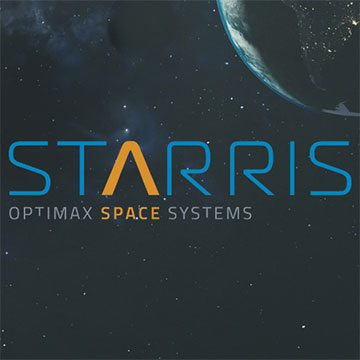
[Image: Starris]
Optimax Systems, a precision-optics manufacturer based in Ontario, NY, USA, announced in early August the launch of a spinoff company focused on developing optical imaging systems and instruments for space applications.
The new venture, known as Starris: Optimax Space Systems, has an ambitious stated aim of enabling customers to take payloads from idea to orbit in less than a year. Starris says its agile technology can be used for applications including Earth observing, space infrastructure, resource exploitation, space manufacturing and defense.
The booming space economy
Parent company Optimax has worked on space-qualified optics for more than 30 years, including equipping NASA Mars Rovers and commercial projects. With the formation of Starris, Optimax is looking to further capitalize on the commercialization of space by accelerating the development of space-rated optical payloads for other businesses. The company’s leaders say in a press release that they see “unprecedented opportunities” in the growth of this market.
“The global space economy is at an inflection point, poised to nearly triple by 2025, reaching a staggering US$1.8 trillion,” said Optimax President Joseph Spilman. “To accelerate our pace, the industry must shift to a new norm where risk, cost and time to orbit are significantly minimized. That is Starris’s mission … Starris will dramatically reduce the time required to go from concept to orbit with space-qualified optical payloads tailored for aggressive design cycles and rapid deployment.”
A modular approach
So how will Starris get payloads ready to launch on such a short timeline? A key element of the plan is a pre-engineered imaging and instrumentation system that can be customized according to individual preferences. The Starris team believes that many customers new to commercial space ventures have similar mission needs; it hopes to address those with a modular platform comprising ready-made building blocks for a payload.
According to Starris, the platform integrates lenses, telescopes, sensors and electronic control systems with the goal of reducing risk, cost and time in getting optical payloads to space.
According to Starris, the platform integrates lenses, telescopes, sensors and electronic control systems with the goal of reducing risk, cost and time in getting optical payloads to space. The company says its turnkey design system is “supported by a robust testing and manufacturing ecosystem, enabling rapid prototyping to production, with rad-tolerant [radiation-tolerant] design for temperature, vacuum, shock and vibration.”
“Legacy space missions take years, if not decades, to get into orbit,” explained Starris Director and Chief Technical Officer Kevin Kearney. “We are compressing that multi-year cycle by assembling pre-tested modular payloads that, when launched, will be space-tolerant, reliable, and fulfill customer requirements.”
Starris also announced a partnership with US-based sensor manufacturer Teledyne Space Imaging to develop camera solutions for small satellites and lunar ecosystems. In a separate press release covering the Teledyne collaboration, Antonino Spatola, Vice President of Business Development, Marketing and Sales for Teledyne Space Imaging, hinted at an even more ambitious future application: “Our joint development of these compact camera payloads begins to address a growing and significant market as small [satellite] applications move beyond LEO [low-Earth orbit] into the cislunar economy, which is a steppingstone to Mars habitation.”
